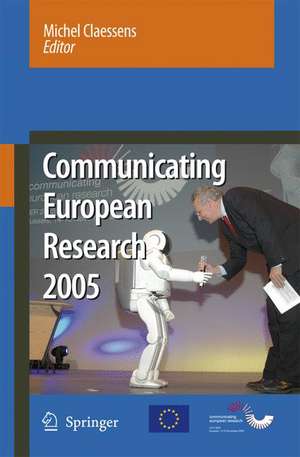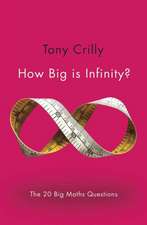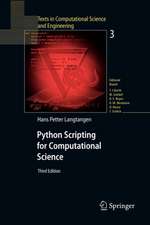Communicating European Research 2005: Proceedings of the Conference, Brussels, 14-15 November 2005
Editat de Michel Claessensen Limba Engleză Hardback – 24 noi 2006
This event was attended by well over 2,100 participants. The contents of this book clearly illustrate that a highly important element of research projects funded by the European Union is communication. Authors include scientists, journalists and communication professionals.
The book covers the main aspects of science and technology communication today and addresses topical questions such as: Is science journalism necessary at all? Should communication become one of the basic skills of scientists, as compulsory as thinking, testing and experimenting? Should our schools of the future put scientific literacy at the top of the science curriculum? Do we need science critics? Does the coverage of science in the media reflect the choice of the editors or does it accurately mirror the public’s interest? How does one capture the public’s attention when promoting science on local, commercial or entertainment radio? Why would we need standards in science communication? How can we remove any obstacles to communication among researchers and between researchers?
The book casts light on these issues and many others. It offers a selection of good practices and professional services to scientists and science communicators, and should help them design and carry out their communication activities with a European and international dimension.
| Toate formatele și edițiile | Preț | Express |
|---|---|---|
| Paperback (1) | 930.76 lei 6-8 săpt. | |
| SPRINGER NETHERLANDS – 23 aug 2016 | 930.76 lei 6-8 săpt. | |
| Hardback (1) | 932.91 lei 6-8 săpt. | |
| SPRINGER NETHERLANDS – 24 noi 2006 | 932.91 lei 6-8 săpt. |
Preț: 932.91 lei
Preț vechi: 1137.71 lei
-18% Nou
Puncte Express: 1399
Preț estimativ în valută:
178.63€ • 184.27$ • 148.05£
178.63€ • 184.27$ • 148.05£
Carte tipărită la comandă
Livrare economică 20 februarie-06 martie
Preluare comenzi: 021 569.72.76
Specificații
ISBN-13: 9781402053573
ISBN-10: 1402053576
Pagini: 248
Ilustrații: XXIV, 248 p.
Dimensiuni: 178 x 254 x 19 mm
Greutate: 0.54 kg
Ediția:2007
Editura: SPRINGER NETHERLANDS
Colecția Springer
Locul publicării:Dordrecht, Netherlands
ISBN-10: 1402053576
Pagini: 248
Ilustrații: XXIV, 248 p.
Dimensiuni: 178 x 254 x 19 mm
Greutate: 0.54 kg
Ediția:2007
Editura: SPRINGER NETHERLANDS
Colecția Springer
Locul publicării:Dordrecht, Netherlands
Public țintă
ResearchCuprins
Why Communicating European Research?.- Thinking Science, Talking Science.- Let’s Make Science The Next Headline.- Information and Communication Technology Research and its Impact on Growth and Job Creation.- The Evolving Context For Science And Society.- Science Communication On Demand.- Bringing Scientists to the People.- “Science Meets Parliament”.- The Science-Media Interface: Interactions of Scientists and Journalists.- Science News on the Net.- The Changing Paradigm of Science Communication: Challenges for Researchers.- Training Scientists in Communication Skills.- Communication of Science, Communication in Science.- Advancing European Protocols for Science Communication.- Science Goes Local: Local Media Matters.- Debate, Communicate, Educate.- Media Skills Workshops: Breaking Down the Barriers Between Scientists and Journalists.- Training for Dialogue and Debate.- Training Science Communication in a Swift Moving Society.- Science Days – contact with science.- The Challenge Of Showing And Discussing The Unknown.- Science & the city.- The Genova Science Festival.- Science Class 2012.- Scientific Literacy.- Perceptions and Images of Science and Science Education.- Representing Science Through Multiple-Channel Digital Television.- How to Get Science in the News.- Heard it on the Radio!.- Communicating Research in Developing Countries.- Getting R&D Results into the Press.- Towards More Responsibility in Communicating Science.- European Media: Two Cultures of Science Communication.- How to reach the business media?.- The Same Old Future.- Europe in Space - Taking off Without the Public?.- Population Exposure to Air Pollutants in Europe (People).- Communicating Eu Food and Health Research.- Communicating Environmental Research.- Talking Nano – What MakesNanotechnology Special.- Communicate Internationally - With Partners from the New Independent States (NIS).- How to Communicate an Interdisciplinary Project?.- When Diversity Means Richness.
Caracteristici
European state-of-the-art in science communication Authors are leading experts in the field A unique collection of good practices A contribution to the improvement of the relationships between science and society














